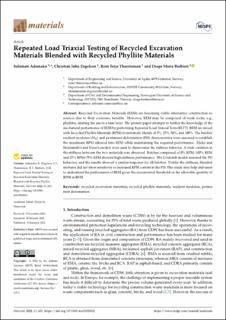Repeated Load Triaxial Testing of Recycled Excavation Materials Blended with Recycled Phyllite Materials
| dc.contributor.author | Adomako, Solomon | |
| dc.contributor.author | Engelsen, Christian John | |
| dc.contributor.author | Thorstensen, Rein Terje | |
| dc.contributor.author | Barbieri, Diego Maria | |
| dc.date.accessioned | 2022-01-29T09:32:08Z | |
| dc.date.available | 2022-01-29T09:32:08Z | |
| dc.date.created | 2022-01-14T14:17:15Z | |
| dc.date.issued | 2022 | |
| dc.identifier.issn | 1996-1944 | |
| dc.identifier.uri | https://hdl.handle.net/11250/2975732 | |
| dc.description.abstract | Recycled Excavation Materials (REM) are becoming viable alternative construction resources due to their economic benefits. However, REM may be composed of weak rocks, e.g., phyllites, limiting the use in a base layer. The present paper attempts to further the knowledge of the mechanical performance of REM by performing Repeated Load Triaxial Tests (RLTT). REM are mixed with Recycled Phyllite Materials (RPM) in systematic blends of 0%, 25%, 50%, and 100%. The batches’ resilient modulus (MR) and permanent deformation (PD) characteristics were assessed to establish the maximum RPM allowed into REM while maintaining the required performance. Hicks and Monismith’s and Uzan’s models were used to characterize the stiffness behavior. A wide variation in the stiffness between the two materials was observed. Batches comprised of 0% RPM–100% REM and 25% RPM–75% REM showed high stiffness performance. The Coulomb model assessed the PD behavior, and the results showed a similar response for all batches. Unlike the stiffness, blended mixtures did not show sensitivity to increased RPM content in the PD. This study may help end-users to understand the performance of REM given the documented threshold on the allowable quantity of RPM in REM. | |
| dc.language.iso | eng | |
| dc.publisher | MDPI | |
| dc.rights | CC BY 4.0 | |
| dc.rights.uri | https://creativecommons.org/licenses/by/4.0/ | |
| dc.subject | Recycled excavation materials | |
| dc.subject | Recycled phyllite materials | |
| dc.subject | Resilient modulus | |
| dc.subject | Permanent deformation | |
| dc.title | Repeated Load Triaxial Testing of Recycled Excavation Materials Blended with Recycled Phyllite Materials | |
| dc.type | Peer reviewed | |
| dc.type | Journal article | |
| dc.description.version | publishedVersion | |
| dc.rights.holder | © 2022 The Authors. | |
| dc.subject.nsi | VDP::Teknologi: 500 | |
| dc.source.volume | 15 | |
| dc.source.journal | Materials | |
| dc.source.issue | 2 | |
| dc.identifier.doi | 10.3390/ma15020621 | |
| dc.identifier.cristin | 1981299 | |
| dc.source.articlenumber | 621 | |
| cristin.ispublished | true | |
| cristin.fulltext | original | |
| cristin.qualitycode | 1 |
Files in this item
This item appears in the following Collection(s)
-
Publikasjoner fra CRIStin - SINTEF AS [5674]
-
SINTEF Community [2225]

